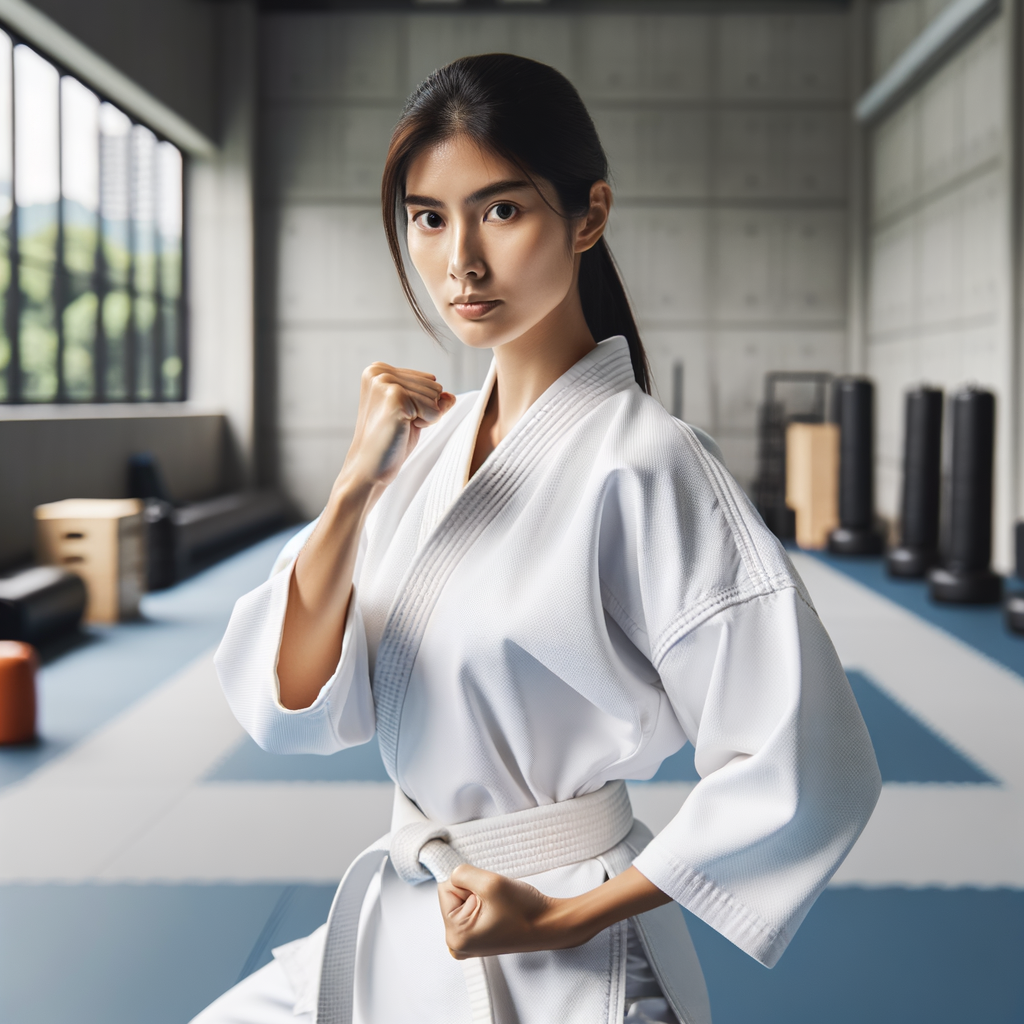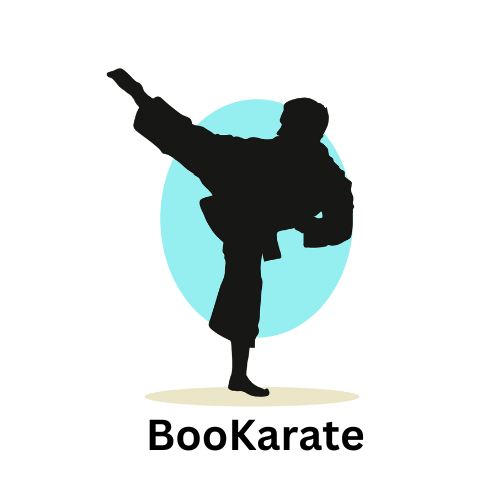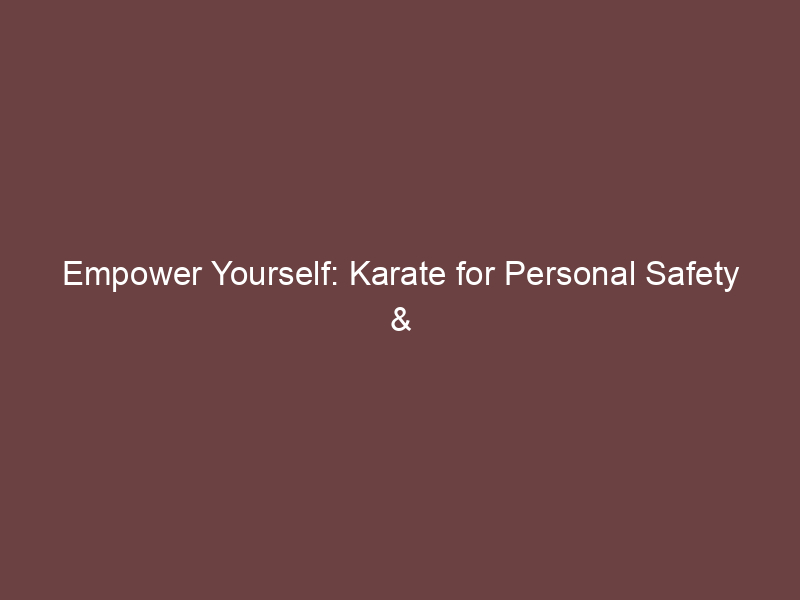
Introduction to Karate for Personal Safety
Personal safety is a concern for everyone, regardless of age or gender. It’s about being aware of our surroundings and knowing how to protect ourselves when danger arises. One way to enhance personal safety is through the practice of Karate. This martial art not only strengthens the body but also sharpens the mind, providing the skills necessary for self-protection.
-
- Understanding the importance of personal safety
Personal safety is paramount. It’s about ensuring that we can navigate through life without fear, confident in our ability to protect ourselves and our loved ones. According to the National Crime Prevention Council, personal safety skills are essential for maintaining a sense of security and reducing the risk of becoming a victim of crime.
-
- The role of Karate in personal safety
Karate plays a significant role in personal safety. As a martial art, it teaches discipline, respect, and self-control. More importantly, it provides practical self-defense techniques that can be used in real-life situations. The American Karate Association states that Karate training enhances personal safety by improving physical strength, agility, and reflexes.
-
- Benefits of learning Karate for self-protection
There are numerous benefits to learning Karate for self-protection. It boosts self-confidence, improves physical fitness, and provides a sense of security. The discipline and concentration learned in Karate also have positive effects on other areas of life, such as academic performance and stress management. A study by the Journal of Physical Activity and Health found that children who practice Karate show improved cognitive performance and lower levels of anxiety.
It empowers individuals with the skills and confidence needed to protect themselves, promoting a safer and more secure lifestyle.
Understanding Karate Self-Defense Techniques
When it comes to personal safety, karate is a powerful tool. It’s not just about the high kicks and swift punches you see in movies. Karate is a martial art that emphasizes self-defense. It provides a variety of techniques that can help protect you in dangerous situations. Let’s delve into some basic and advanced karate self-defense techniques and how they can be applied in real-life scenarios.
- Basic Karate Self-Defense Techniques
For beginners, understanding and mastering basic karate self-defense techniques is crucial. These techniques are simple yet effective in neutralizing threats. Here are a few:
- Front Kick: This is a straightforward technique where you kick forward with the ball of your foot. It’s effective for keeping an attacker at a distance.
- Elbow Strike: This involves striking an opponent with your elbow. It’s useful when the attacker is close to you.
- Block and Counter: This technique involves blocking an attacker’s strike and quickly counterattacking.
- Advanced Karate Techniques for Protection
As you progress in your karate training, you’ll learn more advanced techniques. These techniques require more skill but can provide greater protection. Some of these include:
- Spinning Back Kick: This is a powerful kick that can incapacitate an attacker. It involves spinning around and delivering a kick with the heel.
- Jumping Front Kick: This technique involves jumping and delivering a front kick in mid-air. It’s effective for surprising an attacker.
- Arm Lock: This technique involves twisting an attacker’s arm to immobilize them.
- Practical Application of Karate Techniques in Real-Life Scenarios
Learning karate techniques is one thing, but applying them in real-life scenarios is another. It’s important to practice these techniques regularly so that you can use them effectively when needed. For example, the Front Kick can be used when an attacker is approaching you. The Elbow Strike can be used when an attacker is close to you, and the Block and Counter can be used to defend against an attacker’s strike and quickly counterattack.
Always use these techniques responsibly and only in self-defense situations.
Personal Safety through Karate
One of the key aspects of karate that makes it an excellent tool for personal safety is the physical benefits it offers. Training in karate not only equips you with self-defense techniques but also enhances your physical fitness in several ways. Let’s delve into some of these benefits.
Physical Benefits
Practicing karate regularly can lead to a range of physical improvements. These benefits can significantly contribute to your personal safety by enhancing your ability to protect yourself. Here are some of the primary physical benefits of karate:
-
- Improved Strength and Flexibility
Regular karate training can help you develop stronger muscles and increase your flexibility. This is because many karate moves require a wide range of motion, which can stretch and strengthen various muscle groups. A study by the American Council on Exercise found that martial arts training, including karate, can improve muscular strength and endurance as well as flexibility.
-
- Enhanced Endurance and Stamina
Endurance and stamina are crucial for personal safety, and karate is an excellent way to build these. Karate training involves intense workouts that can increase your heart rate and improve your cardiovascular health. This, in turn, can enhance your stamina and endurance, enabling you to defend yourself effectively for longer periods.
-
- Increased Agility and Reflexes
Agility and quick reflexes are vital for personal safety, and karate can help improve these. The fast-paced nature of karate requires quick movements and reactions, which can sharpen your reflexes and increase your agility. A study published in the Journal of Sports Science & Medicine found that martial arts training can significantly improve agility and reaction time.
The physical benefits of karate can significantly enhance your personal safety. By improving your strength, flexibility, endurance, stamina, agility, and reflexes, karate can equip you with the physical fitness needed to protect yourself effectively.
Mental Benefits of Karate
While the physical benefits of karate are often highlighted, the mental benefits are just as significant. Let’s explore how karate can boost your mental well-being.
-
- Boosted Confidence and Self-Esteem
Learning and mastering new karate techniques can significantly boost your confidence and self-esteem. A study conducted by the American Psychological Association found that children who participated in martial arts, including karate, showed improved self-esteem compared to their peers who did not engage in such activities. This confidence is not just limited to the dojo but extends to other areas of life as well.
-
- Enhanced Focus and Concentration
One of the key aspects of karate is the ability to focus. Karate requires a high level of concentration, as you need to pay attention to your opponent’s moves and react accordingly. This enhanced focus can translate to better concentration in other areas of life, such as school or work. A case study of a fifth-grade classroom showed that students who participated in a karate program had improved focus and concentration compared to those who did not.
-
- Stress Relief and Improved Mental Health
Physical activity, including karate, is known to reduce stress levels. The act of focusing on your movements and breathing in karate can have a calming effect, similar to mindfulness meditation. Moreover, the social aspect of attending karate classes can also contribute to improved mental health. A survey conducted by the National Alliance on Mental Illness found that people who engage in group physical activities report lower stress levels and better mental health.
| Mental Benefit | Description |
|---|---|
| Boosted Confidence and Self-Esteem | Improvement in self-esteem through the mastery of new karate techniques. |
| Enhanced Focus and Concentration | Improved concentration through the practice of focusing on opponent’s moves. |
| Stress Relief and Improved Mental Health | Reduced stress levels and improved mental health through physical activity and social interaction. |
Equipping Yourself with Karate
When it comes to personal safety, karate is a powerful tool. However, it’s not just about learning a few moves. It’s about equipping yourself with the right knowledge and skills. This includes choosing the right karate style for you.
Choosing the Right Karate Style for You
There are many different styles of karate, each with its own unique techniques and philosophies. Choosing the right one for you can be a daunting task, but it’s an important step in your karate journey. Here’s how to go about it:
-
- Understanding different Karate styles
There are several karate styles, each with its own unique focus. Some styles, like Shotokan, emphasize power and strength. Others, like Wado-Ryu, focus more on speed and agility. Understanding these differences can help you choose a style that aligns with your personal goals and capabilities.
-
- Choosing a style based on personal goals and capabilities
Think about what you want to achieve with your karate training. Are you looking to improve your physical fitness? Do you want to learn self-defense techniques? Or perhaps you’re interested in the mental and spiritual aspects of karate? Your goals can guide your choice of karate style. Also, consider your physical capabilities. Some styles may be more physically demanding than others, so choose a style that matches your fitness level.
There’s no ‘best’ karate style. The best style is the one that suits you and helps you achieve your personal goals. So, take your time, do your research, and choose wisely.
Starting Your Karate Training
Embarking on your Karate journey is an exciting step towards personal safety. Here are the key steps to get you started:
-
- Finding a reputable Karate school or instructor
Choosing the right Karate school or instructor is crucial. Look for an instructor who is certified and has a good reputation. You can ask for recommendations from friends or search online for reviews. Remember, a good instructor should not only be skilled in Karate but also be able to teach effectively.
-
- Preparing for your first Karate class
Before your first class, ensure you are physically prepared. This includes eating a healthy meal a few hours before and staying hydrated. Dress in comfortable, loose clothing. Arrive early to familiarize yourself with the environment and meet your instructor and classmates.
-
- Progressing in your Karate training
Progress in Karate is not just about mastering techniques but also about personal growth. Be patient with yourself, as learning Karate is a journey, not a destination. Regular practice, persistence, and a positive attitude will help you progress in your training.
The goal of Karate is not just to learn self-defense techniques, but also to build character, improve physical fitness, and promote personal safety. So, embrace the journey and enjoy each step of your training.
Karate Safety Skills
When it comes to personal safety, Karate offers a unique set of skills that can help you protect yourself in various situations. Let’s delve into some of these key safety skills.
-
- Understanding the principles of self-defense
Self-defense is more than just knowing how to throw a punch or a kick. It’s about understanding how to protect yourself and others from harm. In Karate, the principles of self-defense are rooted in awareness, avoidance, and action. This means being aware of your surroundings, avoiding conflict whenever possible, and taking action when necessary.
-
- Learning to anticipate and avoid dangerous situations
One of the most important safety skills you can learn from Karate is how to anticipate and avoid dangerous situations. This involves understanding the signs of potential danger and knowing how to react. For example, if you notice someone acting suspiciously, the best course of action might be to cross the street or go into a crowded place. Karate teaches you to be alert and aware, helping you make smart decisions that can keep you safe.
-
- Using Karate techniques effectively for self-defense
While Karate is a martial art that involves physical techniques, it’s important to remember that these techniques are meant for self-defense, not aggression. Karate teaches you how to use your body effectively to protect yourself. This might involve blocking an incoming attack, striking an opponent’s vulnerable areas, or using a throw to disable an attacker. Remember, the goal is not to harm, but to protect.
Karate offers a comprehensive set of safety skills that can help you navigate through life more securely. By understanding the principles of self-defense, learning to anticipate and avoid dangerous situations, and using Karate techniques effectively, you can enhance your personal safety and the safety of those around you.
Personal Protection Karate Classes
When it comes to personal protection, Karate is a powerful tool. It not only equips you with physical defense skills but also enhances your mental strength and discipline. Let’s delve into what you can expect in a personal protection Karate class.
What to Expect in a Karate Class
Karate classes are structured and systematic, designed to provide a comprehensive learning experience. Here’s a brief overview of what a typical Karate class entails:
-
- Typical Structure of a Karate Class
A Karate class usually begins with a warm-up session, followed by basic drills to improve agility and coordination. The main part of the class involves learning and practicing specific Karate techniques. The class concludes with a cool-down period and a recap of what was learned.
-
- Learning and Practicing Karate Techniques
In a Karate class, you will learn various techniques such as punches, kicks, knee strikes, and elbow strikes. These techniques are practiced repeatedly to ensure proper form and execution. As you progress, you will also learn advanced techniques and combinations.
-
- Sparring and Real-life Application of Techniques
Sparring is a crucial part of Karate training. It allows you to apply the techniques you’ve learned in a controlled environment. This not only helps you understand how these techniques work in real-life situations but also improves your reaction time and decision-making skills under pressure.
Karate is not just about physical strength; it’s also about mental fortitude, discipline, and respect. As you continue your journey in Karate, you will notice improvements not just in your self-defense skills, but also in your overall character and confidence.
Choosing the Right Karate Class for You
Choosing the right Karate class is a crucial step towards achieving your personal safety goals. It involves understanding your personal needs, researching different classes and instructors, and making the most of your chosen Karate class. Let’s delve into these aspects in detail.
-
Evaluating your personal goals and fitness level
Before you start looking for a Karate class, it’s important to understand why you want to learn Karate. Is it for personal safety, fitness, or both? Knowing your goals will help you choose a class that aligns with your needs. Additionally, consider your current fitness level. Karate requires physical strength and flexibility. If you’re a beginner, look for a class that offers basic training and gradually increases intensity.
-
Researching different Karate classes and instructors
Not all Karate classes are the same. Some focus more on self-defense techniques, while others emphasize traditional Karate forms. Research different classes and instructors to find one that matches your goals. Look for instructors who are experienced, certified, and have a teaching style that resonates with you. Remember, a good instructor can make a significant difference in your Karate journey.
-
Making the most of your Karate classes
Once you’ve chosen a Karate class, it’s time to make the most of it. Attend classes regularly, practice what you’ve learned at home, and don’t hesitate to ask questions. Karate is not just about learning techniques; it’s also about discipline, respect, and perseverance. Embrace these values and you’ll see progress not just in your Karate skills, but also in your overall personal safety and well-being.
Choosing the right Karate class involves careful consideration of your personal goals and fitness level, thorough research of classes and instructors, and a commitment to make the most of your classes. With these steps, you’ll be well on your way to mastering Karate for personal safety.
Conclusion: Safety through Karate Training
In this article, we have explored the importance of Karate for personal safety. As we conclude, let’s take a moment to recap the key points and consider how continuing your Karate journey can lead to lifelong safety and health.
-
- Recap of the benefits of Karate for personal safety
Throughout our discussion, we’ve seen that Karate is more than just a martial art. It’s a tool for personal safety. Karate equips us with self-defense techniques that can be used in real-life situations. It enhances our physical strength and mental alertness, making us more capable of protecting ourselves and others. The safety skills learned in Karate are not just for the dojo, but for everyday life.
-
- Continuing your Karate journey for lifelong safety and health
Learning Karate is a journey, not a destination. The more you train, the more proficient you become in your self-defense skills. But the benefits of Karate extend beyond personal safety. Regular Karate training promotes physical health, mental resilience, and emotional balance. It’s a lifestyle choice that can contribute to your wellbeing for a lifetime.
Indeed, Karate offers a holistic approach to personal safety. It empowers us with the skills and confidence to protect ourselves, while also promoting lifelong health and wellbeing. So, why not continue your Karate journey? Remember, the goal is not to be better than others, but to be better than you were yesterday. As the famous Karate saying goes, “The ultimate aim of Karate lies not in victory or defeat, but in the perfection of the character of its participants.”






